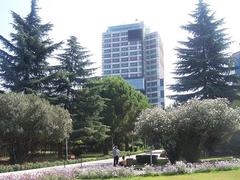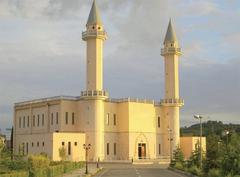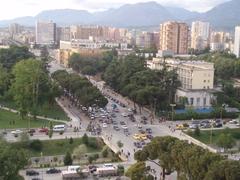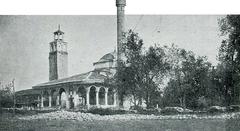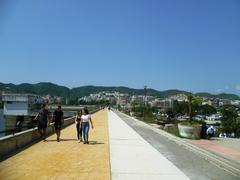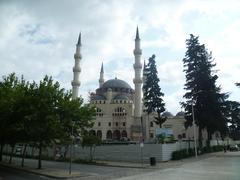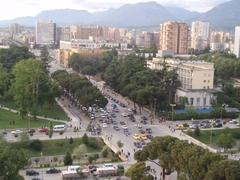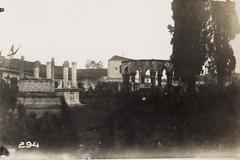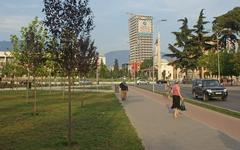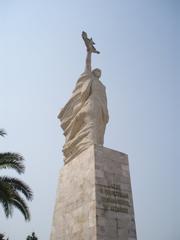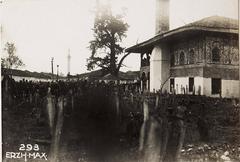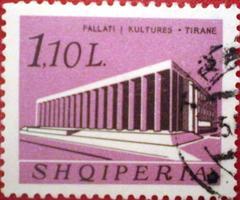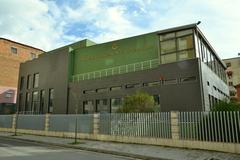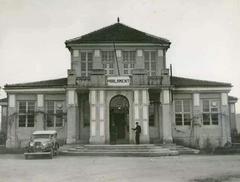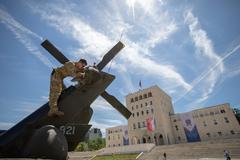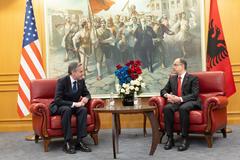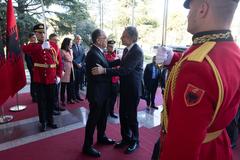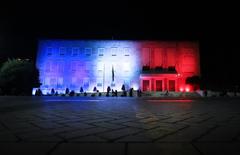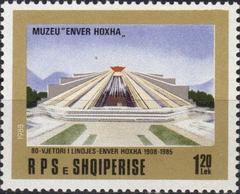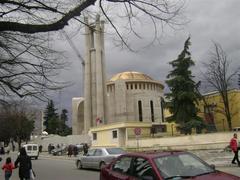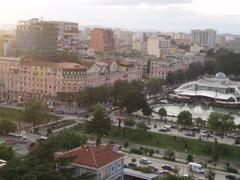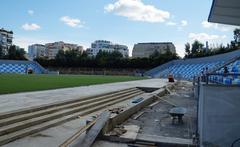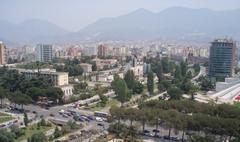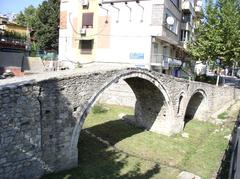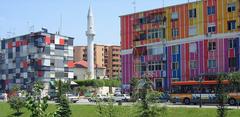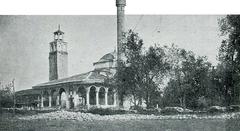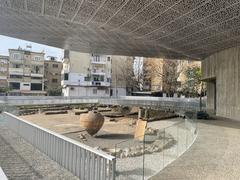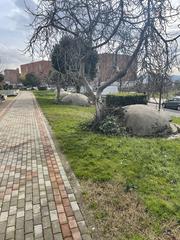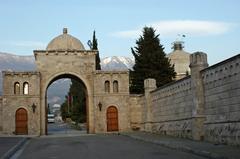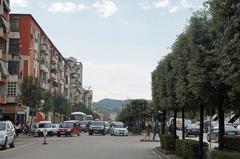Zemra E Krishtit Catholic Church, Tirana: Visiting Hours, Tickets, and Historical Significance
Date: 14/06/2025
Introduction
Zemra e Krishtit Catholic Church, known in English as the Church of the Sacred Heart of Christ, is one of Tirana’s most significant religious, historical, and cultural landmarks. Located in the city’s vibrant center, this church stands as a symbol of Albania’s rich Catholic heritage, architectural innovation, and the enduring faith of its community. Whether you are a history enthusiast, architecture lover, or spiritual seeker, Zemra e Krishtit offers a profound glimpse into the tapestry of Albanian identity.
Table of Contents
- Early Foundations and Construction
- Architectural Features and Artistic Details
- The Communist Era: Suppression and Survival
- Restoration and Contemporary Role
- Visiting Information: Hours, Tickets, and Practical Tips
- Frequently Asked Questions (FAQs)
- Symbolism, Legacy, and Community Life
- Plan Your Visit and Further Resources
Early Foundations and Construction (1938–1939)
The origins of Zemra e Krishtit date back to the late 1930s, a period marked by cultural shifts and foreign influences in Albania. Designed by the Italian architect Giovanni Santi, the church was constructed between 1938 and 1939. Its official inauguration took place on Christmas Eve, December 24, 1939, at the height of the Italian occupation. Zemra e Krishtit was the first Albanian church dedicated to the Sacred Heart of Christ, and it quickly became Tirana’s main Catholic parish (tiranatriennale.com, Visit Tirana).
From the start, the church served both Latin and Albanian Greek-Catholic (Byzantine) rites, reflecting the city’s diverse Catholic traditions. This dual function signified a spiritual and cultural unity during a time of national transformation.
Architectural Features and Artistic Details
Giovanni Santi’s original design is a harmonious blend of Neo-Romanesque, neo-classical, and neo-Byzantine elements. The symmetrical façade, crafted in light stone and stucco, is accented by arched windows and classical columns, while the domed rooflines and the original iconostasis (now lost) showcase Byzantine influence. Though plans included a bell tower, it was not completed until expansion works resumed in 2021 (tiranatriennale.com).
Inside, the nave is illuminated by vibrant stained glass windows, donated by Maja Jacomoni di San Savino, casting colorful light and creating a serene spiritual atmosphere. The sanctuary is framed by a semi-circular apse, and post-communist restorations have introduced new frescoes and murals depicting Christ, the Virgin Mary, and Albanian Catholic martyrs.
The church’s Marian imagery, especially the depiction of Our Lady of Shkodra, holds special significance for the Albanian faithful. Memorials to martyrs such as Dom Stefan Kurti and Archbishop Vinçens Prennushi further cement Zemra e Krishtit’s role as a site of memory and resilience.
The Communist Era: Suppression and Survival (1967–1990)
Albania’s declaration of state atheism in 1967 under Enver Hoxha led to the closure and repurposing of many religious sites. Zemra e Krishtit was transformed into the “Rinia” cinema, with its religious façade concealed and interior artworks damaged or destroyed. Despite these hardships, the core architectural structure was preserved, thanks in part to local architect Maks Velo, who ensured that temporary modifications did not permanently erase the original building (tiranatriennale.com).
Restoration and Contemporary Role
Following the end of communism, the church was restored to the Catholic community in 1991. The reopening, attended by Mother Teresa, marked a significant moment in Albania’s spiritual revival. Restoration efforts included repairing the façade, reviving interior frescoes, and, in recent years, constructing the long-awaited bell tower. In 2007, Zemra e Krishtit was designated a national cultural monument, securing its preservation for future generations (tiranatriennale.com).
Today, the church remains an active center of worship, cultural events, and community engagement. It is administered by the Jesuit order, which fosters education, interfaith dialogue, and social outreach (Jezuitët).
Visiting Information: Hours, Tickets, and Practical Tips
Location and Accessibility
- Address: Rruga e Kavajës, Central Tirana, Albania
- Nearby: Skanderbeg Square, National History Museum, Et’hem Bey Mosque (Visit Tirana)
Visiting Hours
- Weekdays: 6:30 AM – 12:00 PM; 4:00 PM – 7:30 PM
- Weekday Masses: 7:00 AM; 6:00 PM
- Sundays: Masses at 9:00 AM, 11:00 AM, 6:00 PM, and 7:00 PM (Italian language service at 7:00 PM)
- Note: Hours may vary during religious festivals or special events—verify locally or on the Jesuit website.
Admission and Tours
- Admission: Free (donations welcome)
- Guided Tours: Available through local operators or by arrangement with the parish (pine.al)
Dress Code and Etiquette
- Modest attire required (shoulders and knees covered)
- Remove hats inside the sanctuary
- Maintain silence during services
- Photography permitted in some areas, but restricted during Mass—ask for permission
Accessibility
- Wheelchair access is available at the main entrance, though some historic areas may be less accessible
Facilities
- No onsite café or gift shop; many options nearby
- Basic restrooms may be available
Getting There
- By bus: Multiple local routes stop nearby (check current schedules)
- By taxi: Widely available and affordable
- On foot: Easily reachable from central Tirana landmarks
Safety and Local Customs
- Tirana is generally safe; exercise standard precautions
- Respect religious customs, especially during festivals
Frequently Asked Questions (FAQs)
Q: What are the opening hours?
A: Typically, the church is open from 6:30 AM–12:00 PM and 4:00 PM–7:30 PM on weekdays, with extended hours for Sunday Masses.
Q: Is there an entrance fee or ticket required?
A: No, entry is free, but donations are appreciated.
Q: Are guided tours available?
A: Yes, tours can be arranged through local operators or the parish.
Q: Is the church wheelchair accessible?
A: Yes, the main entrance has ramps, but some areas may have limited accessibility.
Q: In what languages are services conducted?
A: Mainly in Albanian, with some services in Italian.
Q: Can I take photographs inside?
A: Photography is generally allowed outside services; ask for permission before photographing during religious events.
Q: What are nearby attractions?
A: Skanderbeg Square, National History Museum, Et’hem Bey Mosque, and the Blloku district.
Symbolism, Legacy, and Community Life
Zemra e Krishtit stands as a monument to Albania’s journey through faith, oppression, and renewal. Its architecture blends Western and Eastern Christian traditions, while its history reflects the resilience of Tirana’s Catholic community. The church remains a hub for religious festivals, cultural events, and educational initiatives, including the new library dedicated to Zef Valentini, enhancing its role as a center of learning and dialogue.
The site’s association with Mother Teresa, the presence of memorials to local martyrs, and its ongoing restoration—including the completion of the original bell tower—underscore its importance as both a spiritual and national symbol.
Plan Your Visit and Further Resources
- Download the Audiala app for guided tours, offline maps, and the latest updates on Albanian cultural heritage.
- For current visitor information and Mass schedules, consult the Jesuit community website.
- Explore more Tirana attractions on Visit Tirana.
Summary and Recommendations
Zemra e Krishtit Catholic Church is a living testament to the endurance, artistry, and spiritual vibrancy of Albania’s Catholic community. Its central location, architectural beauty, and storied history make it a must-visit destination for anyone exploring Tirana or Albania’s broader religious landscape. Plan ahead, respect local customs, and take the time to appreciate both the church’s historical depth and its ongoing role in community life.
Sources and Further Reading
- Church of the Sacred Heart of Christ – Tiranatriennale
- Visit Tirana – Tourism Board
- Jesuit Community in Albania – Jezuitët
- Wander-Lush: Travel Tips for Albania First-Time Visitors
- Audiala Cultural Heritage App
- pine.al
- The Holistic Backpacker
For updated visitor information and special event schedules, always consult official sources or contact the church directly before planning your visit.
